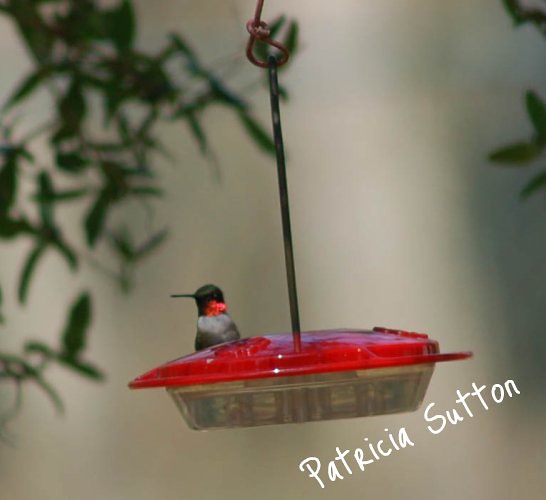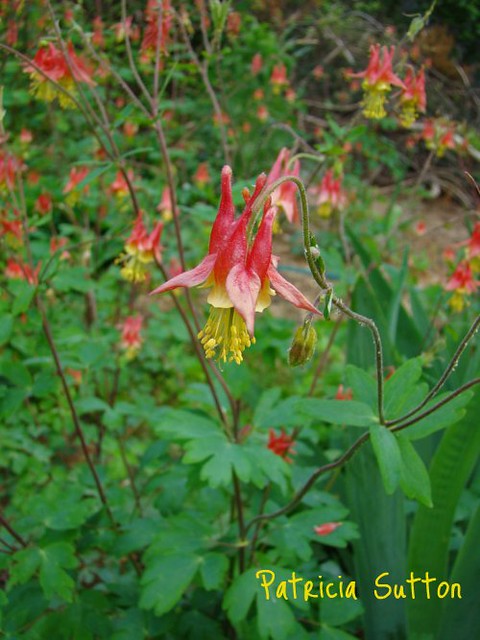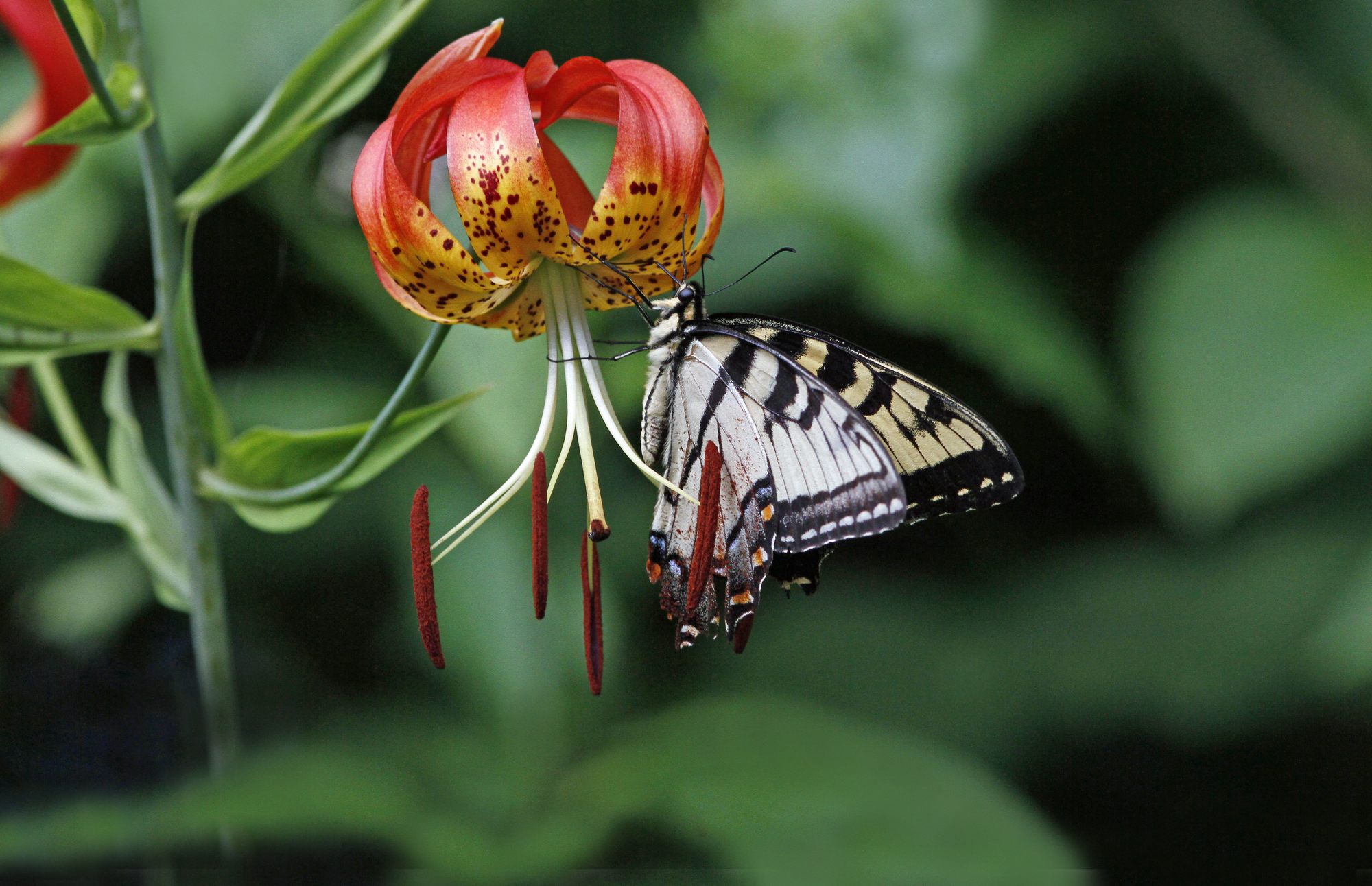T H E Y ‘ R E B A C K !

Hi Gardening Gang,
Thel Brown wrote to let me know that she had a Ruby-throated Hummingbird visit her West Deptford garden yesterday (Saturday, April 2) in Gloucester County, NJ (up near the Delaware River).
Don’t know about you, but I worked feverishly last night to get ready for them in my own yard. I boiled up a quart of solution (1 cup sugar & 4 cups of water), let it cool down in the refrigerator, and this morning filled and hung 4 feeders, hither & yon. I stored the extra solution in my refrigerator. This time of year you don’t need to fill your feeders, since activity is minimal (1 territorial male and maybe 1 female a week or so later, if you’re lucky). I only put 2 ounces in each feeder & will empty them, clean them thoroughly, & refill with 2 ounces of fresh solution once a week (unless the weather turns HOT & then clean & refill more frequently. I don’t fill the feeders with 4 ounces each until activity picks up in late June (when the first batch of young are “on the wing”).
Our Ruby-throated Hummingbirds have spent the winter in southern Mexico (and as far south as Costa Rica). They arrived in the U.S. in late February and have been moving north, keeping pace with the opening of their favorite flowers.
So far all my garden has to offer is the first few flowers on my Flowering Quince shrubs and budding Red Maple trees. My Coral Honeysuckle vine recently leafed out, but I don’t even see buds yet. SO feeders are crucial now to newly arrived hummers.
Keep track of their movements by following this terrific website Hummingbirds.net
I’m looking forward to teaching a program all about Ruby-throated Hummingbirds for NJ Audubon’s Nature Center of Cape May on April 16 (Saturday). Consider joining me! The more you know about these winged jewels, the better your chances are of attracting hummingbirds to your own garden & holding on to them by knowing and practicing wildlife-friendly gardening. Details follow:
 April 16 (Saturdays) — 1 to 3 pm
April 16 (Saturdays) — 1 to 3 pm
“Hummingbirds 101 — All About Ruby-throated Hummingbirds & How to Attract Them — with Pat Sutton”
at NJ Audubon’s Nature Center of Cape May, 1600 Delaware Avenue, Cape May, NJ 08204 (609-898-8848)
Get ready, get set, Ruby-throated Hummingbirds are coming. Where have they been all winter? In the Tropics! Why leave a tropical area to return to New Jersey? Will more than one settle into a backyard garden? Where is the nest? What does the female use to build her tiny nest? Do I need to buy bottled nectar for my feeder? Is red dye needed in feeders? Did you know that hummingbirds like spiders (for at least two reasons)? Even if you think you know everything about these winged jewels, expect to be surprised by what you learn during this presentation by Pat Sutton, naturalist and wildlife gardener. She will show you an a actual hummingbird nest and will share essential tips on how to ready your yard so that you can be entertained by a blizzard of hummingbirds for the next five months. Before this program, download, print, and read the NJ Audubon articles by Pat Sutton: “How to Create a Butterfly and Hummingbird Garden” & “Recommended Plantings to Attract Hummingbirds, Butterflies, and Moths.”
Limit: 30 participants; preregistration is required. Cost: $15 member of NJ Audubon Society, $20 nonmember (includes handouts).
Take advantage of the following great opportunities to add additional hummingbird nectar plants to your garden:
April 30 (Saturday) — 10 a.m. to 3 p.m.
“Backyard Habitat Plant Swap“
at NJ Audubon’s Nature Center of Cape May
1600 Delaware Avenue, Cape May, NJ 08204 (609-898-8848)
This year’s theme is caterpillar host plants! Now is the perfect time to thin out the perennial garden and share some of your garden success with others. Admission to the swap is one plant and a new or used garden tool. The new or used garden tool is your “shower gift” to help the nature center stock up on equipment to use in educational gardening programs. For your admission, you will be entitled to take one “swap plant” home with you. Bring additional plants to swap on a 1:1 ratio. Plants may be dropped off on Friday, April 29th, and you will be given a credit voucher to use on your return on Saturday. Please check out our Web site for a list of caterpillar host plants at NJ Audubon’s website. Admission: One plant and one new or used garden tool.
May 6-7 (Friday-Saturday)
Native Plant Sale & Native Plant Swap at the
Unitarian Universalist Congregation of the South Jersey Shore
in Pomona, NJ (Atlantic Co)
organized by fellow wildlife gardener Jesse Connor. Lots of excellent hard-to-find natives will be available, including Black Cherry and Red Cedar trees (in the plant swap). Even if you live outside of Atlantic County, it will be worth the drive. April 1st was the deadline for orders for the Plant Sale (but Jesse may have ordered a few extras of certain goodies). To learn full details about the Plant Sale and the Plant Swap download all 4 documents at the UUCSJS website under the header — UUCSJS Annual Native Plant Swap & Sale.
May 21-22 (Saturday & Sunday) — 10 a.m. to 3 p.m.
ORDER BY April 30th for pick up May 21 & 22
10th Annual Plant Sale (for Wildlife Gardens)
at NJ Audubon’s Nature Center of Cape May
1600 Delaware Avenue, Cape May, NJ 08204 (609-898-8848)
Your gardens will be the buzz, tweet and talk of the neighborhood when you get off to a good start with top-quality plants. We emphasize the use of New Jersey native plants, which benefit wildlife and have a strong ornamental appeal for the backyard landscape. Some non-native (but non-invasive) perennials and annuals, which offer an added boost to butterfly gardens, will also be available. For an order form, call the nature center at 609.898.8848 or go to the NCCM’s 10th Annual Plant Sale Order Form.
HAPPY SPRING & HAPPY GARDENING,
Pat




 Hi Gang,
Hi Gang, Hi Gang,
Hi Gang,